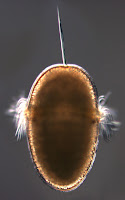This picture shows a chiton egg which I collected from the plankton on February 8th,
2012, off of a dock in Charleston, OR. Chitons are marine mollusks characterized by
a shell made up of eight separate plates. Chiton shell plates washed up on the
beach are often referred to as “butterfly shells.” Chiton eggs are very distinctive
because they are surrounded by a thick and often ornate hull (as seen in this
picture). The hull has been found to reduce the sinking rate of the egg as well
as to focus sperm to specific regions on the egg surface (Buckland-Nicks, 1993)
.
This is a trochophore larva that hatched out of a
chiton egg. Chiton trochophores have a long apical tuft and an equatorial ciliary
band called a prototroch, which you can see on this picture. Chiton
trochophores are different from any other kind of trochophore because their two
eyes are located posterior to the prototroch (instead of anterior). After a few
days of development these larvae begin to form shell plates.
This picture shows seven transverse bands on the dorsal side of the larva posterior
to the prototroch. These bands delineate the boundaries of the future shell
plates; the eighth plate appears later in development (anterior to the
prototroch). The dark band is part of the mineral skirt, which can be seen more clearly in the photo below. The foot and mouth of the chiton is developing on the ventral
surface.
I took this picture using polarized light to show the mineral
spicules in the epidermis surrounding the shell (this area is called the
girdle) and the seven initial shell plates which are beginning to form.
Buckland-Nicks, J. 1993. Hull capsules of chiton eggs: parachute structures and sperm-focusing devices? Biological Bulletin. 184: 269-276.







No comments:
Post a Comment